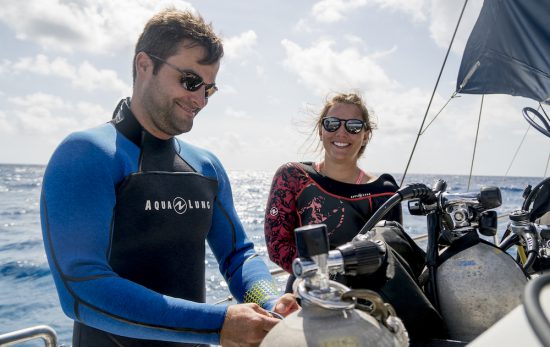Until about five years ago, most of us living in the West had never heard of the shisa kanko Japanese safety procedure. But now, because it has proven particularly effective in Asia, it’s on our radar, with people who apply risk management procedures increasingly integrating it into their safety practices. There’s not only clearly a place for it in diving’s safety culture, but in fact, you’re probably already applying it to some extent without realizing it.
Loosely, shisa kanko means “point-and-call,” and it is simply that. During checks, reading instruments, changing a setting, doing anything in which it is reasonably possible to do so, one points clearly and meaningfully at the item and then out loud states the status, data, setting confirmation, completion of related action, etc. – even when alone. It does not replace our existing procedures, but rather, makes them more effective. As simple as this sounds, data show it makes a surprisingly positive difference.
Point-and-call started with the rise of Japan’s railway system in the early 20th century. How exactly it started is a bit hazy and there are different stories, but by 1917 it was a formal part of training Japanese rail workers. It’s thought that amid the loud ambient noise involved with train operation, workers communicated more effectively, but beyond that, it was soon noticed that thanks to prominent gesturing and speaking, workers were more aware and purposeful as they did things. It is still taught and practiced today.
And that may be one reason why Japan’s railways, including their high-speed trains, have the world’s best safety record, and why other domains, including aviation and medicine, are starting to adopt and encourage it. Research suggests that point-and-call reduces errors as much as 85% by improving our attention when carrying out tasks, particularly repetitive tasks. It is thought to formalize the mindfulness that we often do naturally, making it more effective as something we do consciously instead of unconsciously.

Point and Call in Diving
Shisa kanko clearly fits with how we enact dive safety procedures, but depending upon where you are, you may need some cultural adjustments. It’s thought that there’s some resistance to point-and-call (even in Japan) because some people find it embarrassing to use the broad gestures and loud vocalizations typical of Japanese railway workers. So, while still pointing/touching/doing and speaking, be culturally appropriate (i.e. toned-down) as necessary to encourage divers (and yourself!) to use it.
With that in mind, you probably already do some point-and-call during your pre-dive safety check; shisa kanko simply adds conscious emphasis. Plus, by making checks more visible, it may encourage other buddy teams to not skip them. For instructors, it doubles as a teaching tool that reinforces what students are learning. It might look like this:
You: “B — BCD.” [You inflate with your low pressure inflator using a deliberate visible motion.] “Inflator works. Partially inflated.”
Buddy: “B — BCD.” [Does same.] “Inflator good. Partially inflated.”
You: [You deflate slightly with a deliberate motion] “Deflator works. No leaks. Still partially inflated.”
Buddy: [Does same] “Deflator good. No leaks. BCD inflation still good.”
And so on. For parts of the buddy check that don’t involve actually hands-on breathing, adjusting, inflating, etc., clearly point, gesture or put a hand on what you’re checking. For example:
You: [Point to your alternate air source (AAS), buddy puts hand on it as if to take it] “Alternate second secure in chest area.”
Buddy: [Points to AAS, you put your hand on it.] “Alternate secure in chest area, check.”
Since point-and-call has been shown to work when you’re alone, apply it during the dive even when your buddy can’t hear it. Checking your submersible pressure gauge (SPG) or computer, for example, point to it and say what you’re reading out loud while signaling the information to your buddy. When you can’t point by hand (maybe both are occupied, or if you have limited arm use), “point” by tilting/nodding your head in the desired direction. Or, if you speak by signing, use sign in place of voice.
Admittedly, you may feel a little funny doing it at first (even alone), but that feeling quickly passes when you notice that it makes a difference because you pay more attention to what you’re doing. After you catch one or two mistakes that would have been serious or highly inconvenient, you’ll likely make it a habit that you apply to a lot of things, not just diving. It really works.
Seek adventure. Save the ocean.
Dr. Drew Richardson
PADI President & CEO.



